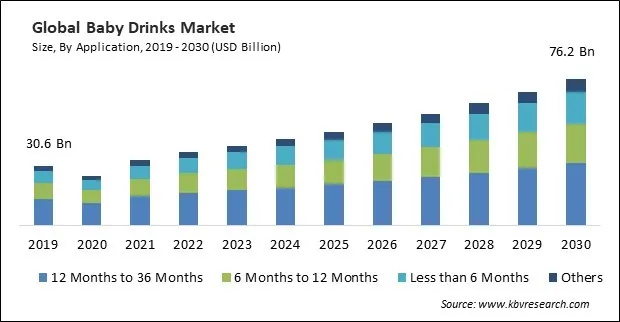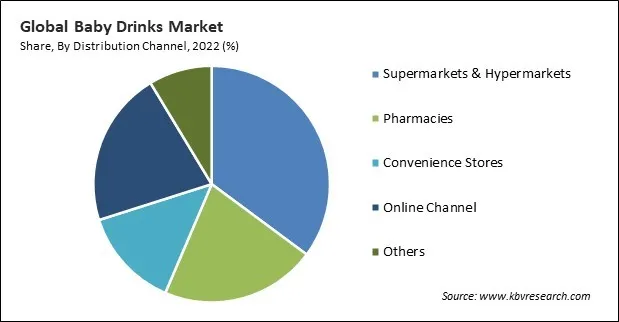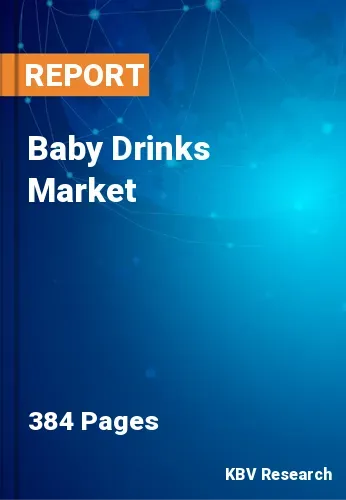The Global Baby Drinks Market size is expected to reach $76.2 billion by 2030, rising at a market growth of 9.2% CAGR during the forecast period. In the year 2022, the market attained a volume of 1,369.5 Kilo Tonnes, experiencing a growth of 9.3% (2019-2022).
In Europe, health and wellness trends significantly impact consumer choices. Therefore, the Europe region captured $8,416.9 million revenue in the market in 2020. Parents in Europe are often conscious of the nutritional needs of their infants and seek products that align with their preferences for natural, organic, and health-focused options. This emphasis on health will likely contribute to the growth of baby drinks that offer added nutritional benefits. As a result, there will be an increased demand in the segment. Some of the factors impacting the market are increasing health and nutrition trends, rising disposable income in many countries, and prevalence of allergies in infants.

Parents are actively seeking baby drinks that go beyond basic nutrition. Products fortified with essential vitamins and minerals, including calcium for bone health, iron for cognitive development, and DHA for brain development, are gaining popularity. These added nutrients contribute to the overall well-being and growth of infants. Docosahexaenoic acid (DHA), an omega-3 fatty acid, supports infant brain and vision development. These enriched with DHA, are especially sought after, as parents recognize the significance of this nutrient during the early stages of cognitive development. Additionally, higher disposable income levels often translate to an increased willingness among parents to invest in premium and high-quality products for their infants. This includes baby drinks that are perceived as offering additional benefits and superior nutritional value. The premiumization trend in the baby food and beverage sector reflects the consumer preference for products beyond basic nutrition. Premium baby drinks may feature organic ingredients, advanced formulations, and enhanced nutritional profiles, catering to parents who prioritize quality and are willing to pay a premium. These aspects will pose lucrative growth prospects for the market.
However, due to their heightened susceptibility to allergy development, infants are frequently advised against having potential antigens introduced into their diets by their parents. Common allergens found in these, such as cow's milk or soy, can trigger allergic reactions in sensitive individuals, leading parents to avoid these products. Allergic reactions in infants can manifest as skin rashes, gastrointestinal issues, respiratory problems, or more severe symptoms. The perceived risk of triggering allergic responses can deter parents from choosing baby drinks that contain allergenic ingredients. These aspects can restrain the growth of the market in the coming years.
On the basis of application, the market is divided into 6 months to 12 months, less than 6 months, 12 months to 36 months, and others. The 12 months to 36 months segment recorded the maximum revenue share in the market in 2022. As babies transition from breast milk or infant formula to a more varied diet, there is increased demand for drinks designed specifically for children aged 12 to 36 months. These drinks may be fortified with nutrients that support the nutritional needs of toddlers during this critical stage of growth and development. Owing to these factors, the segment will grow rapidly in the coming years.
Based on distribution channel, the market is divided into supermarkets & hypermarkets, pharmacies, convenience stores, online channel, and others. In 2022, the pharmacies segment witnessed a substantial revenue share in the market. Pharmacies often position themselves as health and wellness destinations. The increasing emphasis on providing nutritionally sound options for infants aligns with the core values of many pharmacies. These fortified with essential vitamins and minerals may find a natural place on the shelves of pharmacies, as these products contribute to the health and well-being of infants.

Based on product type, the market is segmented into infant formula, baby electrolyte, and baby juice. The infant formula segment held the largest revenue share in the market in 2022. Infant formulas are scientifically designed to deliver vital nutrients that are necessary for the maximum development and growth of neonates. Many formulas are fortified with vitamins, minerals, and other beneficial components, such as DHA (docosahexaenoic acid) for brain development and iron for cognitive function. Parents often choose infant formulas as a reliable source of comprehensive nutrition for their infants.
| Report Attribute | Details |
|---|---|
| Market size value in 2022 | USD 38.2 Billion |
| Market size forecast in 2030 | USD 76.2 Billion |
| Base Year | 2022 |
| Historical Period | 2019 to 2021 |
| Forecast Period | 2023 to 2030 |
| Revenue Growth Rate | CAGR of 9.2% from 2023 to 2030 |
| Number of Pages | 384 |
| Number of Tables | 750 |
| Quantitative Data | Volume in Kilo Tonnes, Revenue in USD Billion, and CAGR from 2019 to 2030 |
| Report coverage | Market Trends, Revenue Estimation and Forecast, Segmentation Analysis, Regional and Country Breakdown, Porter’s 5 Forces Analysis, Company Profiling, Companies Strategic Developments, SWOT Analysis, Winning Imperatives |
| Segments covered | Product Type, Distribution Channel, Application, Region |
| Country scope |
|
| Companies Included | Reckitt Benckiser Group PLC, Danone S.A., HiPP GmbH & Co. Vertrieb KG, Nestle S.A, The Hain Celestial Group, Inc., Campbell Soup Company, Abbott Laboratories, Arla Foods, Inc., Bobbie Baby, Inc., and Holle baby food AG |
| Growth Drivers |
|
| Restraints |
|
By region, the market is segmented into North America, Europe, Asia Pacific, and LAMEA. The Asia Pacific segment procured the highest revenue share in the market in 2022. The Asia Pacific region is characterized by a large and growing population, with several countries experiencing high birth rates. Increasing urbanization, a transformation in lifestyles, and the magnitude of the population collectively contribute to a substantial demand for infant products, including baby drinks. Economic growth in many APAC countries has led to an increase in disposable income levels.
Free Valuable Insights: Global Baby Drinks Market size to reach USD 76.2 Billion by 2030
The market research report covers the analysis of key stake holders of the market. Key companies profiled in the report include Reckitt Benckiser Group PLC, Danone S.A., HiPP GmbH & Co. Vertrieb KG, Nestle S.A, The Hain Celestial Group, Inc., Campbell Soup Company, Abbott Laboratories, Arla Foods, Inc., Bobbie Baby, Inc., and Holle baby food AG.
By Application (Volume, Kilo Tonnes, USD Billion, 2019-2030)
By Distribution Channel (Volume, Kilo Tonnes, USD Billion, 2019-2030)
By Product Type (Volume, Kilo Tonnes, USD Billion, 2019-2030)
By Geography (Volume, Kilo Tonnes, USD Billion, 2019-2030)


This Market size is expected to reach $76.2 billion by 2030.
Increasing health and nutrition trends are driving the Market in coming years, however, Prevalence of allergies in infants restraints the growth of the Market.
Reckitt Benckiser Group PLC, Danone S.A., HiPP GmbH & Co. Vertrieb KG, Nestle S.A, The Hain Celestial Group, Inc., Campbell Soup Company, Abbott Laboratories, Arla Foods, Inc., Bobbie Baby, Inc., and Holle baby food AG.
In the year 2022, the market attained a volume of 1,369.5 Kilo Tonnes, experiencing a growth of 9.3% (2019-2022).
The Supermarkets & Hypermarkets segment is registering maximum revenue in the Market, by Distribution Channel in 2022; thereby, achieving a market value of $25.3 billion by 2030.
The Asia Pacific region is generating the highest revenue in the Market, by Region in 2022, and would continue to be a dominant market till 2030; thereby, achieving a market value of $35.1 billion by 2030.
Our team of dedicated experts can provide you with attractive expansion opportunities for your business.

